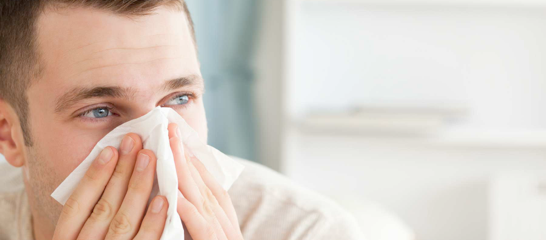




Ways Viruses are Spread
-
•Breathing air droplets that contain a virus from an infected person’s coughs and sneezes.
-
•Touching an object or surface that has a flu virus on it and then touching your eyes, nose, or mouth. Flu viruses can infect a person for 2 to 8 hours after being left on surfaces like door handles, remote controls, and phones.
Many people, most of them smokers, develop emphysema (destruction of the air sacs) with chronic bronchitis. This is chronic obstructive pulmonary disease (COPD).
-
•A cough with mucus or phlegm for 3 or more months at a time. This occurs for more than 2 years in a row.
-
•Shortness of breath with exertion (in early stages).
-
•Shortness of breath at rest (in later stages).
You cannot get a cold if you sit or sleep in a draft, go outside when your hair is wet, or do not wear a jacket in cold temperatures. You cannot get H1N1 flu from eating pork or pork products. People infected with seasonal flu or H1N1 flu may be able to infect others for up to 7 days after the start of symptoms or until they have been symptom-free for more than 7 days. Children and people with weakened immune systems could be contagious for more than 7 days. Each year, 36,000 people die from pneumonia and other serious problems from seasonal flu. Get updates on H1N1 flu-related problems and deaths from www.flu.gov. The risk for serious problems from seasonal and/or H1N1 flu increase with these conditions:
-
•Asthma, bronchitis, emphysema, or other chronic lung disease.
-
•Diabetes. Heart disease. Kidney disease.
-
•Pregnancy.
-
•A weakened immune system from an illness or medication that lowers the immune response.
-
•Very severe health conditions, such as cerebral palsy, epilepsy, muscular dystrophy, and sickle cell disease.

Video



Resources



HealthyLearn®
www.HealthyLearn.com. Click on MedlinePlus®.

Questions to Ask


Self-Care / Prevention
-
•Get vaccines† for seasonal flu and H1N1 flu, as advised by your doctor. Note: Persons with a severe allergy to eggs should not get flu shots. {†Learn up-to-date advice for vaccines from the Centers for Disease Control and Prevention (CDC) at 800.CDC.INFO (232.4636) or www.cdc.gov/vaccines.}
-
•If you get flu symptoms, call your doctor. Ask if flu testing, an antiviral medicine, or medical care is needed. Note: Some antiviral medicines cause mental status changes in older persons and may be worse than flu symptoms.
-
•Cover your nose and mouth with a tissue when you cough and sneeze. Throw the tissue away after you use it. If you do not have a tissue, cough or sneeze into your elbow or upper sleeve.
-
•Wash your hands often with soap and water. Take at least 20 seconds each time. When you can’t wash your hands, use alcohol-based wipes or gels to clean your hands. Rub the gel type into your hands until they are dry.
-
•Avoid touching your eyes, nose, and mouth.
-
•Try to avoid close contact with people and their things when they have a cold or flu symptoms. If you are sick, avoid contact with others so you do not spread the flu.
-
•Stay home from work, school, and errands when you are sick. Do not send your children to childcare or school if they are sick.
-
•Clean and disinfect commonly used objects, such as door handles, phones, railings, light switches, and remote controls.
-
•Rest and drink plenty of fluids. Eat chicken soup.
-
•Use over-the-counter (OTC) saline nasal drops or spray, such as Ocean brand. Use as directed.
-
•Gargle with warm salt water. Mix 1⁄4 teaspoon of salt in 1 cup of warm water.
-
•Use a cool-mist vaporizer to add moisture to the air.
-
•If needed, take OTC medicines to reduce fever and pain and to relieve cough and congestion. Take these as directed. Note: Do not give aspirin to anyone under 19 years old. Aspirin and other medicines with salicylates have been linked to Reye’s syndrome. Do not give OTC medicines for colds, coughs, and flu to children under 6 years old, unless advised by their doctors.
-
•Eat nutritious foods. Do regular exercise. Manage stress. Get enough sleep.
-
•For a sore throat, see Self-Care / Prevention.
Common Health Problems » Respiratory Conditions
The difference between a cold & the flu is often distinguished by the time it takes to feel sick. Source: CVS Caremark Health Resources
Is a fever and/or other symptoms, like coughing, getting worse?



With a cold, does a child have one or more of these problems?
-
•Blue color around the lips, fingernails, or skin.
-
•Quick breathing or a very hard time breathing.
-
•Grunting sounds with breathing.
-
•Severe cough or wheezing.
-
•Fever of 100.4ºF or higher in a baby less than 3 months old; 104ºF or higher in a child between 3 months and 3 years old.


Does an adult have any of these problems?
-
•Blue color around the lips, fingernails, or skin.
-
•Severe or increasing shortness of breath.
-
•Severe wheezing.
-
•Coughing up true red blood.
With a cold or the flu, do any of these problems occur?
-
•Wheezing or trouble breathing.
-
•Ear pain or swollen, painful neck glands.
-
•Headache that doesn’t go away.
-
•Sore throat that is very red or has white spots.
-
•A cough with mucus that is yellow, green, or gray.
-
•A bad smell from the throat, nose, or ears.
-
•Fever of 99.5ºF and up to 100.4ºF in a baby less than 3 months old.
-
•Fever of 102.2ºF and up to 104ºF in a child 3 months to 3 years old.
-
•Fever over 104ºF in a person 3 to 64 years old.
-
•Fever of 102ºF or higher in a person age 65 and older.
-
•Fever and/or other symptoms, like coughing keep getting worse.




Have you had the flu or a cold for more than a week and not felt better with self-care? Or, do you have new symptoms?



Treatment


Self-care treats colds and most cases of the flu. Prescribed antiviral medicines can make flu symptoms milder and help you get better sooner if started within 48 hours of the onset of flu symptoms.
Other medications to relieve symptoms may also be advised by your doctor.
Antibiotics do not treat cold and flu viruses. Antibiotics treat infections from bacteria. Taking them for viruses is a main cause of antibiotic resistance. With this, bacteria that were once fought off by antibiotics have become stronger than the medicine. Certain bacteria have become so resistant that it is hard to find an antibiotic that is able to fight off the infection. An example is MRSA - Methicillin-resistant Staphylococcus aureus. This can cause an infection that affects the skin or causes pneumonia. MRSA resists treatment from usual antibiotics.


Symptoms*
Cold
Seasonal Flu
H1N1 Flu





Fever.
Cold & Flu Comparison Chart

Rare.
Common.
Can be high fever.
Usual. 20% of people may not have a fever.

Chills.
Not common.
Common.
Common.

Headache.
Not common, but can occur due to sinus pressure.
Common.
Very common.

Body Aches.
Slight.
Severe.
Severe.

Fatigue.
Mild.
Moderate to severe.
Moderate to severe.

Itchy/Watery Eyes.
Common.
Not common.
Not common.

Stuffy Nose.
Common.
Runny nose is common.
Not common.

Sneezing.
Common.
Common.
Not common.

Sore Throat.
Common.
Common.
Not common.

Cough.
Cough with mucus.
Often. Dry and hacking cough.**
Usual. Dry cough without mucus.**

Diarrhea/Vomiting.
None.
Not common. More likely to occur in children than adults.
Sometimes.

Chest Pain or Discomfort.
Mild to moderate.
Moderate.**
Often severe.**

Onset of Symptoms.
Develop over a few days. Symptoms mostly affect you above the neck.
Sudden. Symptoms affect the body all over.
Sudden. Symptoms affect the body all over.
-
*Symptoms can vary from person to person.
** A dry cough that turns into one with mucus and/or chest discomfort that becomes severe could be a sign of a secondary infection.

Cold


Seasonal Flu
Causes

Different strains of type A and type B viruses for that year’s fall and winter months.
More than 200 different cold viruses.
H1N1 Flu

H1N1 virus. It was first detected in people in Mexico and in the U.S. in April of 2009. At first, this was called swine flu. In June, 2009 it was declared a pandemic flu - one that causes a global outbreak of serious illness that spreads easily from person-to-person.

To Treat a Cold or the Flu


-
•Rest.
-
•Drink lots of liquids.
-
•Take an over-the-counter medicine for pain and/or fever as directed.
-
•Use over-the-counter saline nasal drops or spray, such as Ocean brand. Use as directed on the label.
-
•Use a cool-mist vaporizer. This adds moisture to the air.
-
•Eat chicken soup. It helps clear out mucus.
-
•Take echinacea, zinc lozenges, and/or vitamin C as advised by your doctor when cold or flu symptoms start. Don’t take echinacea and/or zinc lozenges long term. These do not prevent colds and flu.
-
•Suck on lozenges and hard candies to moisten a sore throat. (Don’t give these to children under age 5).
-
•Gargle with: Warm salt water (1/4 teaspoon of salt in 1 cup of water) or 1 tablespoon of hot water mixed with 1 tablespoon of mouthwash.
-
•Don’t suppress a cough that brings up mucus. Ask your pharmacist for an over-the-counter expectorant medicine with guifenesin. {Note: See information on “Expectorant” in Your Home Pharmacy.}
-
•For a sore throat, see Self-Care / Prevention under Sore Throat topic.



With or after the flu, do any of these symptoms of meningitis occur?
-
•Stiff neck (can’t bend the head forward to touch the chin to the chest).
-
•Severe headache that persists.
-
•Red or purple rash that doesn’t fade when the skin is pressed.
-
•Seizure.
-
•Lethargy.
-
•In an infant, bulging of the fontanelle (soft spot of the skull).



Do flu symptoms improve, but return with a fever and a worse cough?



With or after the flu, do these signs of dehydration occur?
-
•Feeling confused.
-
•Very little or no urine.
-
•Sunken eyes.
-
•Dry skin doesn’t spring back after being pressed.




Do you have pain or swelling over your sinuses that gets worse when you bend over or move your head, especially with a fever of 101ºF or higher?


2012 © All Rights Reserved - American Institute for Preventive Medicine | Disclaimer | Phone: 800.345.2476 | www.HealthyLife.com


